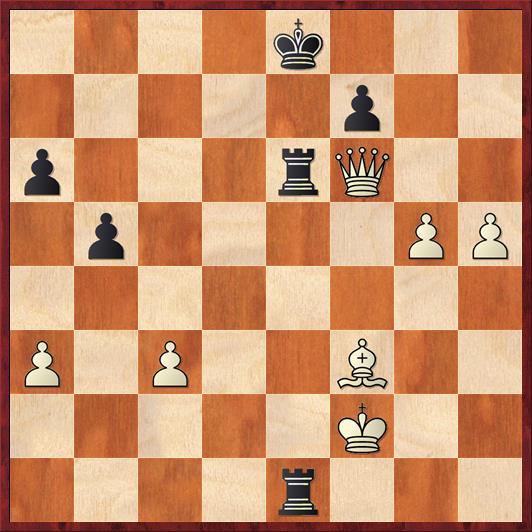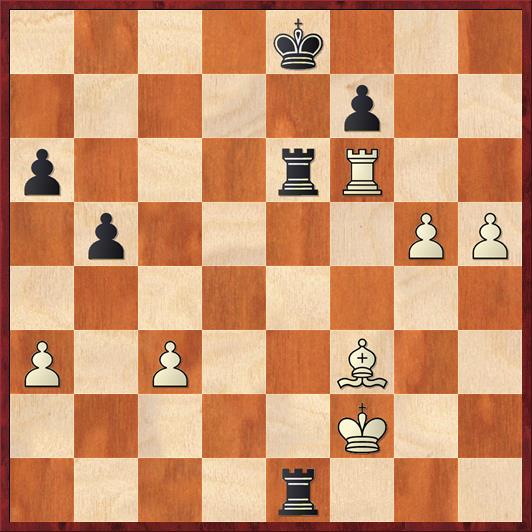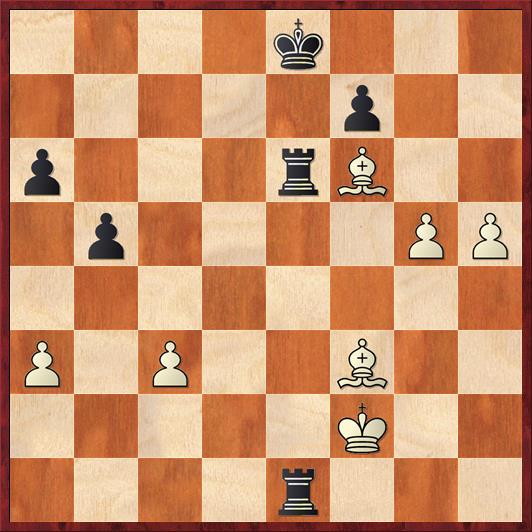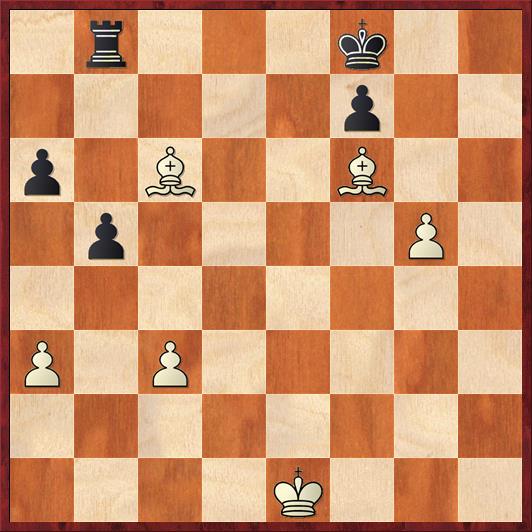In honor of our new “alternative facts” universe, I decided to delete my chess rating against Shredder (the computer program) and start over with no rating. After 925 games against it, I was unsatisfied with the fact that my rating had gone below 2000. It just wasn’t right! The alternative fact is that my rating is 2400. Also, I’m alternatively 24 years old and really good-looking. Yup.
So, after a few false starts and resets, I am now on a pretty good roll. After 7 games, the “new me” has a record of 5-2 and a rating of 2283. Okay, it’s not 2400, but at least it’s better than being under 2000.
My latest game was not terribly interesting overall, but it had kind of a cute final position.
 Position after 60. … Re6. White to move.
Position after 60. … Re6. White to move.
FEN: 4k3/5p2/p3rQ2/1p4PP/8/P1P2B2/5K2/4r3 w – – 0 61
Of course there are a zillion ways for White (me) to win this position, but can you find the cutest one?
(Space inserted in case you want to think about it.)
The move I played was 61. h6!, and Shredder resigned immediately. The point is that after 61. … Rxf6 62. gf, Black has no way to stop my h-pawn. The bishop on f3 controls the two key entry squares h1 and h5, so that Rh1 and Re5-h5 don’t work. The pawn on f6 blocks Re6-h6 and Re7-h7, and Black’s own king blocks Re8-h8. Also, the pawn on f6 prevents Kf8-g7, and finally 62. … Ra1 63. h7 Ra2+ Kg3 gets nowhere for Black because my king covers h2.
I thought this was really cool, but it’s not such a great puzzle because everything wins for White; 61. h6 is just the icing on the cake. So let’s try a little bit of alternative-facting!
 Position after 60. … Re6 (alternative universe). White to play and win.
Position after 60. … Re6 (alternative universe). White to play and win.
FEN: 4k3/5p2/p3rR2/1p4PP/8/P1P2B2/5K2/4r3 w – – 0 61
Now this puzzle is somewhat interesting. Again, White plays 61. h6! Taking the rook is, of course, as futile as before, but Black has a new try: 61. … Kf8 62. h7 Kg7, apparently stopping the pawn. How does White break through?
The answer is a cute sacrifice, 63. Rxf7+! If 63. … Kxf7 64. h8Q Black’s rooks cannot get organized in time to stop the g-pawn. So Black has to play 63. … Kh8, and now 64. g6! creates unsolvable problems for Black. He can’t play 64. … Rxg6 65. Kxe1, and he has to stop the threat of Rf8+, so 64. … Re8 looks forced. And then 65. Bc6! takes advantage of the overloaded e8 rook. It has to defend its comrade on e1 but it also has to defend the back rank, and it can’t do both. Checks on e2 and e3 accomplish nothing. At best Black can sacrifice the exchange with something like 65. … R1e7 66. Bxe8 Rxe8, but this is extremely hopeless.
That was a pretty nice problem! But why stop there? Let’s make the queen a bishop!
 Position after 60. … Re6 (alternative universe 2). White to play and win.
Position after 60. … Re6 (alternative universe 2). White to play and win.
FEN: 4k3/5p2/p3rB2/1p4PP/8/P1P2B2/5K2/4r3 w – – 0 61
Once again the winning move is 61. h6! Here 61. … Kf8 is obviously of no help at all, but Black does have a new defensive possibility with 61. … Kd7, planning … Re8. Here I tried really hard to make 62. Bg4?! work, and I’m sure that a skilled problem composer would be able to tweak the position so that it does. Unfortunately, in this position after 62. Bg4 Rh1 63. Kg2 Rh4 64. Kg3 Rh1 65. Bh3 Kd6 it doesn’t look as if White’s bishop maneuver has gotten anywhere. Instead, the best move is the simplest: 62. h7 Re8 63. h8Q Rxh8 64. Kxe1. White threatens 65. Bb7, and Black has extreme difficulty defending both the queenside pawns and the f7 pawn. The only defense I can see is the ultra-passive 64. … Rb8 65. Bd5 Ke8 66. Bc6+ Kf8 (diagram).
 Position after 66. … Kf8 (analysis). White to move.
Position after 66. … Kf8 (analysis). White to move.
FEN: 1r3k2/5p2/p1B2B2/1p4P1/8/P1P5/8/4K3 w – – 0 67
I feel as if White should be winning here, because Black’s army is split into two camps and his king cannot come to the aid of the queenside. Probably White will just gradually activate his own king and win by force majeure. However, it’s not completely clear. Does anyone have a really convincing line?
As you see, alternative realities can be a lot of fun!
By the way, an interesting thing happened last week that may be of interest only to me. My most recent blog post, “The Edge of the Truth,” attracted the attention of a website called Marginal Revolution and they posted a link to it. As a result, I got my largest number of page views ever in one day (2,891). In fact, the next day also was among my top five busiest days ever, with 1,486 page views.
This kind of thing is fun when it happens. (It also happened last year, to a less extreme extent, when one of my posts got a link on Reddit.) However, I’m not really sure that it does anything for my long-term readership. The Marginal Revolution readers were probably more interested in my thoughts on go and on the effects of computers than they were in chess. Still, in case any of them stuck around and are reading this post, welcome! I hope you’ll keep coming back!
P.S. Another interesting piece of non-chess news: grandmaster Sam Shankland will be one of the contestants on a reality TV show called Kicking and Screaming. It’s a Survivor-type show, where the twist is that ten survivalists are paired with ten couch potatoes who have never been in the wilderness before. Sam is, of course, one of the wilderness newbies. He has the absolute funniest moment in the trailer, when he swings a machete backwards and it sticks in the tree behind him.
I have no idea how Sam got cast onto this show, or when he had time to film it in his busy chess schedule. But it promises to be a hoot! The premiere is on March 9 on the Fox network at 9 Eastern time.



{ 1 comment… read it below or add one }
Hi Dana,
I do think it is great that you are looking for beauty in chess instead of just playing for results. In a practical game I would never have played 61 h6 simply because I would not even be considering it.
What I tell my students is this: When you are winning eliminate counter-play first. The obvious best move to do that is 61. Qd4. It’s completely risk free and now the advance of the h-pawn can not be stopped. Black is virtually in zugzwang.
Trying to force a win can easily lead to disaster. White could have gone wrong with 61. g6? Rf6 62. g7 Rf3+ 63 Kf3 Rg1 64. h6 Ke7 65. h7 Rg7 66. h8/Q Rg6 when it looks like Black might have a fortress draw, although I think White can still win this by pushing the a-pawn.
I thought your choice of 1. h6 is a great example of why it is so hard to get rid of our weaknesses in chess. Many times we can use an inferior or ill-suited thinking process and come up with a great result, so our bad thinking processes get reinforced.
In your final diagram I think White simply has to manufacture a passed pawn on the queenside to win. The easiest way to do that is to bring his king to a5. If Black tries to prevent that by playing a5 and b4 he still loses: 67 Kd2 a5 68. Kc3 b4 69. ab4 ab4 70. c4 and Black has too many problems to survive.